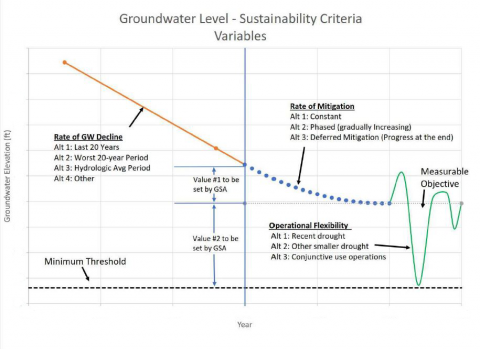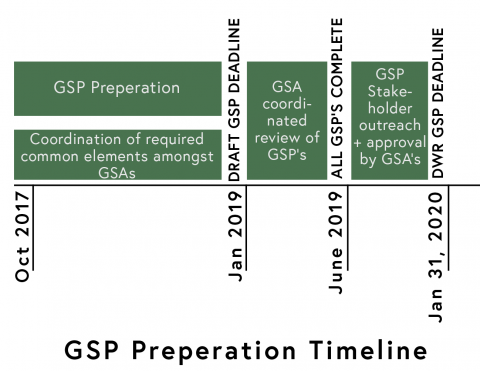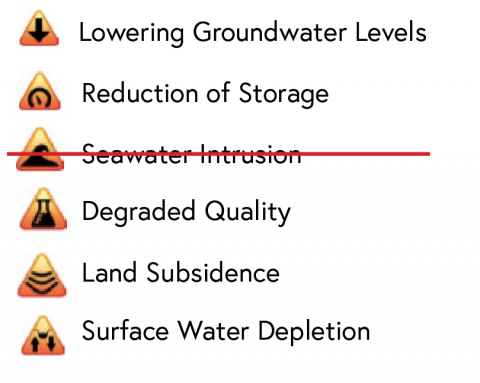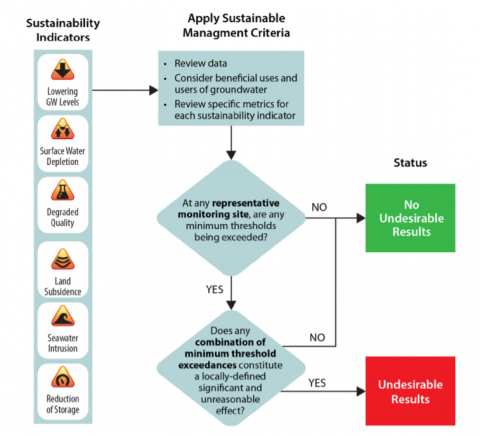Author: Cristel Tufenkjian
Increasing data-driven groundwater management is needed under SGMA; DWR technical services can support that effort
At the October 24th Board Meeting the North Fork Kings GSA Board approved to submit an application for Technical Support Services from the CA Department of Water Resources (DWR) in a move to solve data gaps in the monitoring network. Services available through DWR include the installation of dedicated monitoring wells and video logging to gather construction information on existing wells among others.
Sustainability mandates under SGMA necessitate data-driven groundwater management. A Groundwater Sustainability Plan requirement, the monitoring network is a key data gathering component for establishing and monitoring sustainability goals in the North Fork Kings GSA. Data collected from the network of monitoring wells must be reported annually to DWR; the data will also be an important metric for the North Fork Kings GSA to measure the impacts and results of future projects and management actions on groundwater levels within the service area.
Current groundwater condition insights are drawn from existing monitoring programs including CASGEM (California Statewide Groundwater Elevation Monitoring) and GAMA (Groundwater Ambient Monitoring and Assessment Program), but increased data capacity is needed to sufficiently monitor sustainability progress and ensure the GSA is achieving its mitigation targets.
The GSAs technical consultant, Kevin Johansen of Provost & Pritchard recommends a network density of 2-3 monitoring wells per township. Because of the hydrogeologic variability of the area, which includes multiple clay layers, a confined aquifer, and an unconfined aquifer (unconfined aquifer exists in the absence of clay layer), sufficient network density is important in the North Fork Kings GSA.
The map pictured below illustrates current gaps in the North Fork Kings GSA monitoring network. (Please note the image is a DRAFT.)
North Fork Kings GSA Well Network and Data Gaps
(click to enlarge)
Both existing and newly established dedicated monitoring wells will be used to fill gaps and achieve the recommended network density. To qualify for the monitoring network a well must be accompanied by a Well Completion Report, a document outlining the construction information such as depth and perforated intervals. Because it can be time-consuming work to obtain and match reports with the appropriate well, the GSA plans to take advantage of the Technical Support Services offered by DWR for the installation of dedicated monitoring wells pending application approval.
The well monitoring network will ultimately be the data collection tool providing insight into the trajectory toward sustainable levels of groundwater in the North Fork Kings GSA. The Technical Support Services offered by DWR can help efforts of the GSA to sufficiently monitor groundwater levels.
Project discussions begin as GSP elements progress
At the September 26th Board Meeting technical consultant Kevin Johansen, Provost & Pritchard, presented potential Groundwater Sustainability Plan (GSP) concepts and management actions for consideration. The list included projects across six broad categories: conjunctive use (the combined use of surface water and groundwater), surface water, land management, groundwater use restrictions, water conservation, and “other”.
Conjunctive use projects may include groundwater recharge by means of dedicated basins, injection wells, unlined canals or intentional on-farm recharge. The preliminary list also included supply-side solutions that focus on acquisition of surface water or building additional storage and conveyance. An innovative supply-side solution that made the list: internal surface water trading among growers within the GSA.
On the demand side, land management solutions aim to decrease the amount of water needed. Solutions to achieve this may include land purchase and fallowing by the GSA from willing landowners, or incentives for landowners to convert to less water-demanding crops.
The projects presented are not an exhaustive or definite list, but rather concepts that require further exploration for consideration. Economic constraints will be a key factor in identifying projects that lessen the burden of reaching State-mandated sustainability as the GSA moves toward developing a more detailed project roadmap.
Board selects preferred methodology for recommendation to Kings Subbasin coordinated effort, indicates accuracy is a priority
At the August 1, 2018 North Fork Kings GSA Special Board Meeting, Kevin Johansen of Provost&Pritchard briefly reviewed the alternative methodologies considered for allocating the estimated 206,000 AF of annual groundwater overdraft within the Kings Subbasin. The North Fork Kings GSA Board moved to select its preferred methodology for recommendation to the Kings Subbasin coordination group. The coordination group must still reach an agreement on the methodology that will be used by the entire subbasin.
Below are the five alternative methodologies to determine groundwater overdraft allocation:
Methodology 1: equal subbasin overdraft distribution by GSA acreage
Methodology 2: storage change only within boundaries of individual GSA
Methodology 3: storage change plus groundwater boundary flows between GSA’s
Methodology 4: storage change plus groundwater boundary flows between GSA’s, including historical flow patterns
NEW – Iteration 4A: same as methodology 4, except an adjustment is made for aquifer thickness caused by declining water levels, and uses bookend years of 1999 and 2011 to determine current groundwater flow conditions
NEW – Iteration 4B: same as iteration 4A, except rather than bookend years, averages data from multiple years between 1999 to 2011 to determine current groundwater flow conditions (thus, more data is used in the calculation than in iteration 4A)
Methodology 5: water budget concept: utilizes calculated water demand, and assumes demand not met by surface water delivery/precipitation is met by groundwater pumping
Click here to read our previous post for more detail on the methodologies, including their benefits and shortcomings.
Acknowledging that overdraft numbers will change as quality and quantity of monitoring data is made available, the Board moved to select iteration 4B as its primary preference citing its parameters and data quantity as key indicators of accuracy.
In the absence of coordinated group consensus on iteration 4B, the Board moved to select methodology 4 and 4A as alternative preferences. The difference between current estimated overdraft amounts assigned to the North Fork Kings GSA between methologies 4, 4A, and 4B is minimal, with all falling between 72,000-75,000 AF (numbers are preliminary and subject to change).
The Board’s goal is to set realistic mitigation targets and implement projects to successfully reach sustainability goals. An accurate representation of groundwater conditions will equip the GSA for that goal.
—
Please note that all numbers are preliminary and subject to change pending data improvements.
Board Workshop Discusses Methodologies to Determine Groundwater Overdraft Responsibility within Kings Subbasin, Among Additional GSP Topics
At the June 27, 2018 North Fork Kings GSA Board Workshop, technical consultant Kevin Johansen of Provost & Pritchard provided a detailed update on Groundwater Sustainability Plan (GSP) elements within the context of SGMA-mandated subbasin coordination. Because the State requires sustainability at the subbasin level, the seven Kings Subbasin GSAs are seeking agreement on the methodologies used to develop their individual GSPs.
The coordination group is working towards an overdraft yield estimate within the Kings Subbasin, and are seeking agreement on a methodology to assign appropriate responsibility among each GSA for that overdraft amount. Work to determine unconfined aquifer (unconfined aquifer, as opposed to confined, exists in the absence of a clay layer) storage change and groundwater boundary flows is currently underway.
Using best available monitoring well data, contour maps from the Spring of 1999 and the Spring of 2011 are used to determine aquifer storage change and boundary flows within the Kings Subbasin. Contour maps utilize groundwater elevation (feet above mean sea level) to illustrate the direction that groundwater moves. The map below (click image to enlarge) indicates groundwater elevation levels with numbers along the blue contour lines in the year 2011 in the Kings Subbasin. Water flows perpendicular to these contour lines from higher elevations to lower. The map indicates Kings Subbasin groundwater generally flows from East to West. Please note that the elevation numbers are preliminary and subject to change pending improvements in well monitoring data. Preliminary numbers for unconfined aquifer storage change are calculated for each GSA in the subbasin using groundwater elevation data from 1999 to 2011. The subbasin as an entirety has experienced an estimated average annual storage change of 206,000 AF. Please note these numbers are preliminary and subject to change pending data improvements.
Preliminary numbers for unconfined aquifer storage change are calculated for each GSA in the subbasin using groundwater elevation data from 1999 to 2011. The subbasin as an entirety has experienced an estimated average annual storage change of 206,000 AF. Please note these numbers are preliminary and subject to change pending data improvements.
A methodology for answering the important question of how much overdraft each GSA is responsible for must be agreed upon by the seven GSAs. Johansen outlined five potential methodologies for determining the apportionment of storage change responsibility.
Methodology 1: The approach of this methodology is simply to prorate the subbasin total change in storage (the estimated 206,000 AF) amount based on GSA acreage – in other words, to equally distribute the total change amongst the GSAs by acreage. This method lacks causal explanation for change in storage.
Methodology 2: The second proposed methodology utilizes only change in storage within the boundary of each GSA. This method lacks information on groundwater flow in and out of the GSA.
Methodology 3: The third alternative takes into account the GSA’s change in groundwater storage and its groundwater boundary flows. This method looks at the estimated change in storage in a GSA, together with net boundary flow (water flowing in and water flowing out) to assign responsibility.
Methodology 4: Identical to the third method, except that it accounts for historical flow patterns and its associated benefits or losses to a GSA over a period of time.
Methodology 5: The final methodology utilizes the water budget concept. This method uses calculated water demands for each GSA depending on land use, and assumes that whatever demand not met by surface water delivery or precipitation is met by groundwater pumping.
The current goal is to coordinate amongst the seven Kings Subbasin GSAs on an agreed methodology from the list above. No formal agreement has been made, but methodology 4 represents a holistic and equitable approach in calculating distribution of overdraft responsibility. Although a key component, change in storage is not enough to assign overdraft responsibility to each specific GSA because it excludes additional causal information such as groundwater flows and historical flow impacts. Assigning responsibility is key for each GSA’s individual GSP, as it sets a target for mitigation that can be achieved by projects and management actions.
—
The presentation included preliminary calculations, and covered a broad range of GSP elements including Kings Subbasin Coordination outline in the above article, Water Budget, Sustainable Management Criteria, Preliminary Water Quality Characterization, Management Area Considerations, and Next Steps.
Proposition 218 Election to Fund Local Groundwater Management Passes
Landowners residing in the North Fork Kings Groundwater Sustainability Agency (GSA) voted overwhelmingly in favor of a $10 per acre assessment to cover the costs of locally implementing the new State groundwater regulations. Following the closing of the assessment election public hearing on May 9th, the North Fork Kings GSA Board tabulated and certified the ballot results, which favored the local assessment by 94 percent. A majority vote was needed to pass the per acre benefit assessment; votes were weighted by acreage.
The Board approved and set a rate of $10/acre for the fiscal year 2018-19. Each year, the Board will set a rate not to exceed the $10/acre maximum for the five-year lifespan of the assessment. All landowners within the boundaries of the North Fork Kings GSA will be levied the $10/acre assessment via Fresno and Kings County tax rolls beginning in the fiscal year 2018-19.
Passing the election is a success for the North Fork Kings GSA in keeping SGMA implementation at the local level. The GSA is equipped to move forward with development of the Groundwater Sustainability Plan.
—
An Engineer’s Report was conducted to set the $10/acre assessment rate. The Report calculates the equitable distribution of the benefit derived from each parcel within the agency upon which such assessments will be levied. The Engineer’s Report discusses benefits of the Agency’s organization, proposed actions, and services provided by the North Fork Kings Groundwater Sustainability Agency.
Technical Consultant Updates Board on GSP Development, Outlines Sustainable Management Criteria
At the April 25th study session, North Fork Kings GSA technical consultant Kevin Johansen of Provost & Pritchard presented on the current status of Groundwater Sustainability Plan (GSP) development. The presentation outlined technical requirements of the GSP and future milestones, a completed GSP draft by January 2019 being the nearest. The goal is for all GSA’s within the Kings subbasin to complete individual GSP drafts by the January 2019 deadline, leaving enough time to coordinate a comprehensive subbasin GSP. Final GSP’s must be submitted to the CA Department of Water Resources (DWR) by the required deadline of January 2020.
The timeline below indicates target deadlines.
Sustainable Management Criteria
Overview
The Sustainable Management Criteria is one of several Best Management Practices (BMP) guidance documents created by DWR. These documents were created to provide clarification, guidance, and examples to help GSA’s develop the GSP. DWR defines BMP’s as “the practice, or combination of practices, that are designed to achieve sustainable groundwater management and have been determined to be technologically and economically effective, practicable, and based on best available science.” The BMP’s are guidelines for reaching sustainability by 2040 under SGMA.
Provost & Pritchard discussed next steps to implement the Sustainable Management Criteria. Sustainability according to the Sustainable Management Criteria is achieved by avoiding “significant and unreasonable” results across six Sustainability Indicators. The consultants are working to coordinate amongst the seven GSA’s within the Kings subbasin to establish a methodology for defining “significant and unreasonable” results across the Sustainability Indicators. Once established, that methodology will be used by each GSA to set goals and define sustainability success. The six Sustainability Indicators are listed below. Seawater Intrusion is not relevant due to geographic location.
The “significant and unreasonable” results (ie. a specified level of groundwater elevation decline that is unacceptable) are defined by the GSA and must be accepted by DWR. The following metrics set by the GSA and approved by DWR serve as the measuring stick of sustainability across the Sustainability Indicators:
Minumum Threshold – the lowest result allowed in the worst case scenario. A quantitative value that when exceeded cannot cause an “undesirable result” and thus cannot be an arbitrary number.
Undesirable Result – a result defined by the GSA and approved by DWR in line with DWR’s suggested Best Management Practices. Undesirable results will be used by DWR to determine whether the sustainability goal has been achieved within a basin. Based on minimum threshold exceedances. If caused, sustainability is not successful.
Measurable Objective – average maintained result over the long-term. Must be met by 2040. Success metric of sustainability across Sustainability Indicators.
Each GSA will set its own results and objectives across the Sustainability Indicators using the methodology coordinated amongst the seven GSA’s in the Kings subbasin. For example, all GSA’s within the Kings Subbasin will use the same methodology to set their groundwater level minimum threshold, but for each GSA the specified level (lowest quantitative groundwater elevation allowed in the worst case scenario) will be different.
Example: Reaching Groundwater Level Stabilization
A closer look at the Sustainability Indicator: Lowering Groundwater Levels, illustrates the path toward sustainability under the Sustainable Management Criteria BMP. The relationship between Lowering Groundwater Levels, undesirable results, and minimum threshold is outlined in the flowchart below.
To avoid “significant and unreasonable” results of the Lowering Groundwater Levels, the minimum threshold may not be exceeded to a level that causes undesirable results.
Setting the minimum threshold and measurable objective values for groundwater level sustainability requires a methodology built using three sustainability criteria variables: rate of groundwater decline, rate of mitigation, and operational flexibility. The graphic below illustrates these variables in relation to the change groundwater elevation.
 Each variable can be determined a number of ways, and once determined are used in relationship with one another to set quantitative groundwater elevation levels for the measurable objective and the minimum threshold.
Each variable can be determined a number of ways, and once determined are used in relationship with one another to set quantitative groundwater elevation levels for the measurable objective and the minimum threshold.
Rate of groundwater decline is the rate at which groundwater levels have declined over a set period of time, and can be determined using one of three frameworks:
- Look at last 20 years, or
- Look at worst 20 years, or
- Look at hydrologic average period
Rate of mitigation is the rate at which improvements towards the measurable objective are made, and can be determined one of three ways:
- Constant (small, equal improvements each year), or
- Phased (slow at first with increased rate of progress over time), or
- Deferred mitigation (no progress until last 5 years; not recommended, unlikely to be accepted by DWR)
Operational Flexibility is the range of fluctuation in groundwater level allowed that still maintains the measurable objective average, taking into consideration dry versus wet years. The lowest range level of operational flexibility allowed is equal to the minimum threshold. The range of flexibility can be determined one of three ways:
- Recent drought or
- Other smaller drought or
- Conjunctive use operations (coordinated use of groundwater and surface water)
Provost & Pritchard is working to establish the methodology using the variables above. Using the example of Lowering Groundwater Levels, the technical consultants will recommend how to determine the rate of groundwater decline, the rate of mitigation, and the operational flexibility. The variables will then be used to establish the quantitative groundwater elevations for minimum threshold and measurable objective, and the rate at which the objective is achieved.
The North Fork Kings GSA will need to establish “significant and undesirable” metrics for each of the five relevant Sustainability Indicators. Realistic minimum thresholds and measurable objectives are key to reaching sustainability outlined by SGMA.
—
Additional GSP topics covered during the Study Session include the Water Budget, Monitoring Network, Land Subsidence, and the Proposition 218 Election. The full presentation can be found here: NFKGSA Board Study Session PowerPoint
Prop 218 Assessment Ballots Mailed
Ballots have been mailed for the Proposition 218 Assessment. An assessment is necessary to generate sufficient revenue to fund local implementation of the unfunded State law, the Groundwater Sustainability Management Act (SGMA) and will be used to cover North Fork Kings Groundwater Sustainability Agency (GSA) costs and expenses associated with the development and implementation of a Groundwater Sustainability Plan. The proposed maximum annual assessment is $10.00. It is up to the Board to set the annual assessment rate, and the Board may choose to set the annual rate lower than the maximum $10.00 rate proposed.
It is important that the North Fork Kings GSA has adequate funding to keep implementation of SGMA at the local level. Without the necessary funding to fulfill the requirements of the State law, the CA Department of Water Resources and Water Resources Control Board will step in as a backstop to implement the law. State-developed sustainability plans will differ from locally developed plans in cost, detail, and approach to sustainability. This includes but is not limited to: costly fees, higher frequency monitoring and reporting, and pumping restrictions. State intervention would be many times more costly than what is proposed by the North Fork Kings GSA.
To access resources and additional information on the assessment and its purpose, visit our Prop 218 Groundwater Assessment page.
Ballots must be received prior to the close of the Public Hearing scheduled for 5:30 pm on Wednesday, May 9, 2018, or they will not be counted.
Board Approves 218 Election, Public Hearing May 9
At the January 10, 2018 Board meeting, the Directors of the North Fork Kings Groundwater Sustainability Agency approved the Engineer’s Report to conduct a Proposition 218 Election and set a date of May 9 at 5:30 pm for the public hearing. The Board is requesting landowner approval to levy assessments to fund the activities required to comply with California’s new groundwater law. The necessary funding for the Agency will be reviewed annually by the Board and, depending on the funds projected to be needed for the year, may be approved up to the maximum $10.00 per acre assessment rate.
The proposed fee must be supported by landowners within the North Fork Kings GSA territory. If not, compliance with the new law will still happen but at a higher cost. The State will impose a fee structure on groundwater pumpers many times more costly than what is proposed by North Fork Kings Groundwater Sustainability Agency. You can find the State’s 2018 adopted SGMA fees here.
To view the Engineer’s Report and learn more about the assessment and upcoming outreach events go to www.northforkkings.org/218election.




